I am a research student coming to grips with R for the first time. I am trying to make a PCA plot from a series of body measurements, the specimens names and a subspecies tag (BIN) are in sperate columns. The BIN column contains the BIN ID for each sample. The difficulty I am facing is filtering out individuals with certain BIN's. My desired output is to produce a PCA plot identical to the one below but only displaying the named BIN's ("ACZ5516", "ADF3772") and not the remaining BIN's.
#import data set
Anotylus<-read.csv("DataSO.csv", header = TRUE, sep = ",",
row.names = 1)
#row.names sets specimen ID as specimen name
#set BIN as factor
Anotylus$BIN<-as.factor(Anotylus$BIN)
# Number of BINs and number of individuals in each
table(Anotylus["BIN"])
#create PCA of data set, excludes column for BIN (column 12)
Ano.pca<-PCA(Anotylus[,c(1:11)], graph = FALSE)
#visualise PCA with all individuals in the d.f.
fviz_pca_ind(Ano.pca,
geom.ind = "point",
col.ind = Anotylus$BIN,
repel = TRUE,
legend.title = "BIN",
addEllipses = TRUE)
#With individuals from selected BINs
top<-list(name=c("ACZ5516", "ADF3772"))
fviz_pca_ind(Ano.pca,
geom.ind = "point",
col.ind = Anotylus$BIN,#
select.ind = top,
repel = TRUE,
legend.title = "BIN",
addEllipses = TRUE)
#no samples visible at all
#wouild like to see only the two named
I have tried using a subset of the data but the Principal Components variation changes and produces different a result.
How do I filter the individuals displayed to a curated list?
Any advice or guidance is deeply appreciated!
Best,
Dante
Sample data set below
> dput(Anotylus)
structure(list(Total.Anten.Length..mm. = c(0.66, 0.635, 0.676,
0.559, 1.249, 0.675, 0.704, 0.649, 0.661, 0.795, 0.836, 0.888,
0.941, 0.781, 0.899, 0.918, 0.854, 0.834, 0.888, 0.884, 0.879,
0.776, 0.954, 0.853, 0.96, 0.527, 0.515, 0.653, 0.491, 0.474,
0.538, 0.694, 1.01, 0.53, 0.641, 0.509, 0.918, 0.849, 0.452,
0.536), Body.Length...mm. = c(1.842, 1.664, 1.901, 1.917, 3.061,
1.961, 1.862, 1.99, 1.85, 1.449, 2.455, 2.077, 2.578, 2.478,
2.798, 2.589, 2.291, 2.882, 2.472, 2.55, 2.53, 2.757, 2.689,
2.166, 2.894, 1.944, 1.48, 2.385, 1.715, 1.674, 1.532, 2.27,
2.598, 1.677, 1.67, 1.68, 2.374, 2.877, 1.699, 1.656),
Eye.Area..mm2. = c(0.01,
0.009, 0.01, 0.006, 0.026, 0.007, 0.01, 0.01, 0.009, 0.006, 0.016,
0.014, 0.015, 0.018, 0.02, 0.016, 0.019, 0.015, 0.013, 0.011,
0.015, 0.014, 0.017, 0.014, 0.012, 0.007, 0.006, 0.02, 0.007,
0.006, 0.005, 0.013, 0.013, 0.006, 0.007, 0.005, 0.013, 0.006,
0.008, 0.005), Eye.Width..mm. = c(0.046, 0.036, 0.054, 0.033,
0.071, 0.04, 0.046, 0.047, 0.044, 0.05, 0.059, 0.053, 0.073,
0.063, 0.068, 0.051, 0.044, 0.07, 0.064, 0.061, 0.054, 0.042,
0.038, 0.059, 0.059, 0.043, 0.046, 0.079, 0.037, 0.035, 0.037,
0.054, 0.047, 0.045, 0.045, 0.028, 0.05, 0.037, 0.043, 0.045),
Head.Width..mm. = c(0.359, 0.362, 0.377, 0.317, 0.731, 0.456,
0.38, 0.414, 0.359, 0.453, 0.568, 0.449, 0.519, 0.517, 0.516,
0.515, 0.512, 0.513, 0.511, 0.456, 0.503, 0.474, 0.598, 0.453,
0.574, 0.309, 0.306, 0.574, 0.314, 0.298, 0.295, 0.386, 0.557,
0.289, 0.318, 0.306, 0.505, 0.291, 0.298, 0.263),
Pronotum.Width..mm. = c(0.413,
0.455, 0.439, 0.352, 0.741, 0.462, 0.467, 0.461, 0.442, 0.493,
0.573, 0.549, 0.584, 0.617, 0.632, 0.61, 0.614, 0.624, 0.631,
0.533, 0.587, 0.562, 0.609, 0.522, 0.621, 0.342, 0.341, 0.598,
0.336, 0.314, 0.331, 0.467, 0.547, 0.343, 0.342, 0.317, 0.545,
0.328, 0.329, 0.284), Pronotum.Length..mm. = c(0.304, 0.326,
0.334, 0.24, 0.48, 0.317, 0.303, 0.329, 0.302, 0.36, 0.418,
0.383, 0.424, 0.428, 0.399, 0.442, 0.404, 0.461, 0.435, 0.376,
0.393, 0.403, 0.373, 0.41, 0.435, 0.259, 0.247, 0.403, 0.257,
0.252, 0.23, 0.387, 0.388, 0.248, 0.26, 0.215, 0.336, 0.223,
0.231, 0.247), Elytra.Width..mm. = c(0.558, 0.552, 0.586,
0.43, 0.854, 0.506, 0.528, 0.586, 0.548, 0.54, 0.75, 0.716,
0.794, 0.816, 0.746, 0.82, 0.786, 0.8, 0.722, 0.69, 0.758,
0.766, 0.736, 0.668, 0.852, 0.468, 0.462, 0.741, 0.461, 0.323,
0.406, 0.637, 0.617, 0.41, 0.366, 0.422, 0.718, 0.42, 0.408,
0.278), Elytra.Length..mm. = c(0.469, 0.437, 0.386, 0.346,
0.631, 0.428, 0.464, 0.451, 0.445, 0.532, 0.583, 0.543, 0.558,
0.62, 0.625, 0.623, 0.613, 0.605, 0.623, 0.588, 0.606, 0.48,
0.568, 0.568, 0.598, 0.373, 0.352, 0.516, 0.365, 0.326, 0.327,
0.502, 0.464, 0.346, 0.344, 0.319, 0.519, 0.346, 0.329, 0.346
), Pronotum.Value = c(0.288, 0.319, 0.306, 0.331, 0.179,
0.278, 0.224, 0.211, 0.204, 0.273, 0.26, 0.33, 0.241, 0.218,
0.203, 0.209, 0.241, 0.227, 0.31, 0.236, 0.341, 0.288, 0.283,
0.263, 0.279, 0.173, 0.162, 0.22, 0.183, 0.209, 0.193, 0.185,
0.236, 0.181, 0.172, 0.227, 0.275, 0.164, 0.21, 0.217),
Elytra.Value = c(0.314,
0.319, 0.393, 0.243, 0.205, 0.297, 0.21, 0.205, 0.244, 0.359,
0.288, 0.335, 0.375, 0.291, 0.243, 0.238, 0.288, 0.283, 0.351,
0.271, 0.48, 0.415, 0.325, 0.294, 0.193, 0.182, 0.271, 0.237,
0.216, 0.246, 0.214, 0.193, 0.233, 0.205, 0.18, 0.262, 0.225,
0.176, 0.303, 0.251), BIN = structure(c(1L, 1L, 1L, 3L, 8L,
1L, 1L, 1L, 1L, 4L, 1L, 1L, 1L, 1L, 1L, 1L, 1L, 1L, 1L, 1L,
1L, 1L, 1L, 1L, 7L, 3L, 3L, 6L, 3L, 3L, 3L, 2L, 5L, 3L, 3L,
3L, 5L, 3L, 3L, 3L), .Label = c("ACZ5516", "ACZ5742", "ADF3772",
"ADF4138", "ADG1201", "ADH9095", "ADI3175", "ADR2790"), class =
"factor")), row.names = c("CCDB-22214-D03",
"CCDB-22214-D06", "CCDB-22214-D08", "CCDB-22214-G09", "CCDB-22214-
H02",
"CCDB-22214-H09", "CCDB-22215-A11", "CCDB-22215-A12", "CCDB-22215-
F04",
"CCDB-23850-B07", "CCDB-23851-C04", "CCDB-23851-C05", "CCDB-23851-
C11",
"CCDB-23851-C12", "CCDB-23851-D02", "CCDB-23851-D03", "CCDB-23851-
D04",
"CCDB-23851-D06", "CCDB-23851-E08", "CCDB-23851-E09", "CCDB-23851-
E11",
"CCDB-23851-F03", "CCDB-23851-G05", "CCDB-23851-G09", "CCDB-23858-
B08",
"CCDB-23858-G12", "CCDB-23858-H01", "CCDB-23859-B10", "CCDB-23859-
E07",
"CCDB-23859-E10", "CCDB-23859-E11", "CCDB-25504-E04", "CCDB-25505-
E02",
"CCDB-25510-B12", "CCDB-25510-D02", "CCDB-25510-E09", "CCDB-25511-
B06",
"CCDB-25511-B12", "CCDB-25511-E11", "CCDB-25512-E12"), class =
"data.frame")


